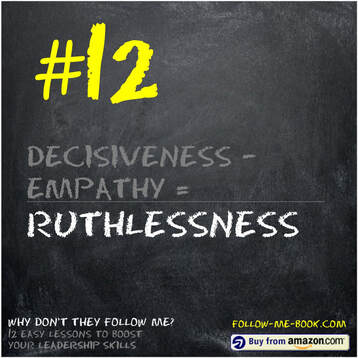0 Comments
The Scenario:

As a young manager I was on a particularly difficult assignment that had attention all the way up to the CEO of the company. The executive leading the project was a very seasoned and intentional leader who executed as well as anyone I’ve ever seen drive a crisis initiative. His ability to stay on top of the work was like nothing like I’d ever seen from other leaders in the organization. During my annual review with him, I asked what he saw as a crucial attribute of a successful leader. Without missing a beat, he gave me two words which continue to shape me as a leader: follow up.
Through the years I’ve seen how follow-up (or lack thereof) contributed to a team’s ability to successfully deliver results. Organizations that have follow-up in their DNA simply execute more friction-free than those who don’t. The leader stays better aligned with the work happening in the organization, and the followers better understand and execute to the leader’s expectations. I’ve seen it in my own experience as a leader. As my leadership skills matured and my follow-up ability became more autonomic, I saw first-hand how we were able to get things done more effectively. I also saw another benefit--my timely follow-up behavior reduced the number and magnitude of crises I had to deal with. I was more on top of what was happening, was better in sync with the team, and more engaged when the team needed my help to get something done. 
Some time back I was the executive sponsor responsible for developing a facility strategy for a new line of business. I empowered one of my project managers to develop the strategy which we would jointly present to our management. We both had visions of what we expected in the strategy but I didn’t ensure our points of view meshed.. My project manager was very competent in her job; however mind-reading was not one of her skills. The day before we were due to present the strategy, I did a walk-through with her. It wasn’t anything like I envisioned, and I knew the strategy in its current state wouldn’t be well received by our management. We went through a fire drill to get the strategy to a state where I thought it would be better received. We survived the review with our management, but it didn’t go nearly as well as it could have gone, and we went through a lot of pain (including a sleepless night) to rework the strategy.

So you're browsing LinkedIn or reading the classifieds and you see the job of your dreams staring you right in the face. You brush up your resume, write a killer cover letter and send it in sealed with a kiss and a prayer. A week later, someone from HR calls telling you they'd like you to come in for an interview. Wahoo!!! So the hard part is over, now you've got the hard part left. To help you nail the interview and be sitting pretty in the job you've always wanted, keep these nuggets tucked in your bonnet:
|
Topics
All
Reprints
Contact Lonnie about article reprints. Please specify article you wish to reprint. Backlist
See Lonnie's Amazon Author Page Archives
July 2024
|
Lonnie Pacelli - Building Thriving Leaders™
Insightful | Creative | Direct Advice to Help Leaders Help Themselves
Keynote Speaker | Board Director | Autism Advocate | Author | Project Management Expert | Microsoft/Accenture Veteran
See his books on Amazon
Insightful | Creative | Direct Advice to Help Leaders Help Themselves
Keynote Speaker | Board Director | Autism Advocate | Author | Project Management Expert | Microsoft/Accenture Veteran
See his books on Amazon
Services |
About
|
© COPYRIGHT 2019. ALL RIGHTS RESERVED.
We are a participant in the Amazon Services LLC Associates Program, an affiliate advertising program designed to provide a means for us to earn fees by linking to Amazon.com and affiliated sites.
|


 RSS Feed
RSS Feed